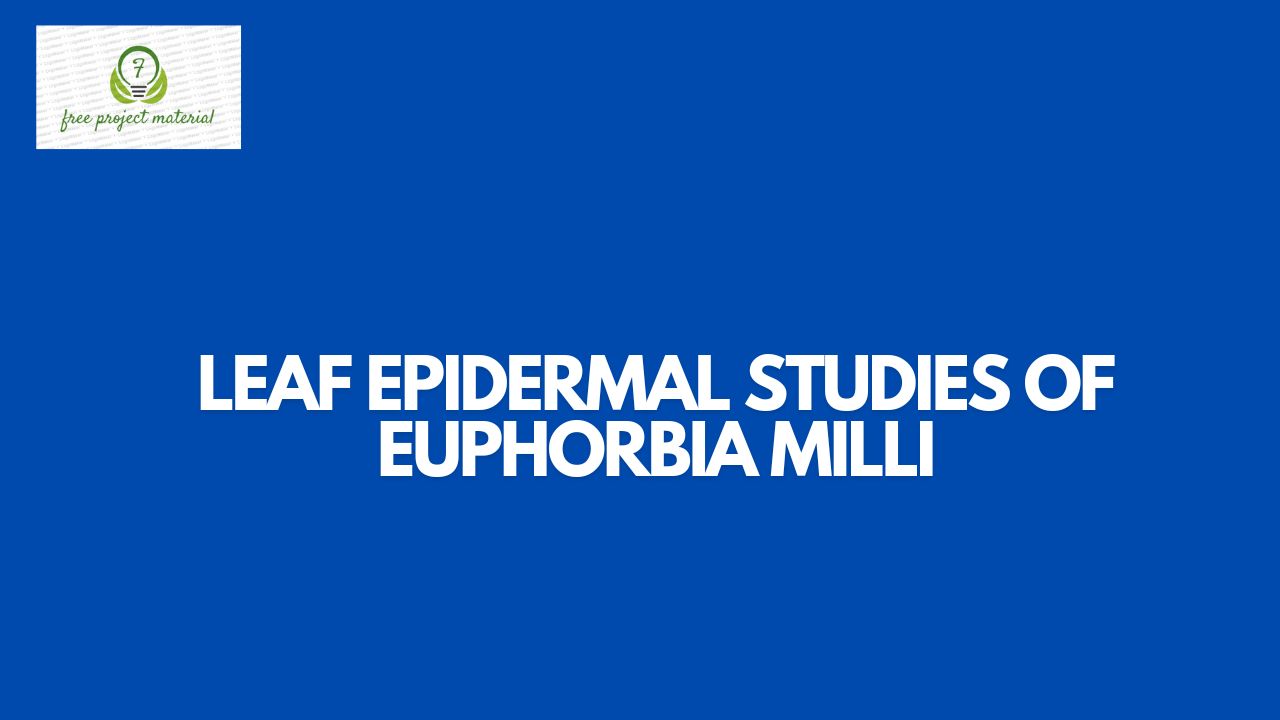ABSTRACT
A taxonomic study of Euphorbia milli was conducted in search of useful and stable anatomical characters for the identification of the leaf of Euphorbia milli showed features of polygonal, straight, irregular, undulate, unicellular and anomocytic stomata. The epidermis is amphistomatic. The abaxial epidermal cell length, Cell width, epidermal length and stomata width was 50.72, 42.98, 49.80 and 12.3µm respectively, while the adaxial epidermal length, cell width, epidermal length and stomata width was 147.87, 180.49, 174.06 and 24.3µm respectively. The specific standards obtained through experimentation are of important in the establishment of diagnostic features for the identification and preparation of monograph on the plant.
TABLE OF CONTENTS
TITLE PAGE- – – – – – – – i
CERTIFICATION- – – – – – – ii
DEDICATION- – – – – – – – iii
ACKNOWLEDGEMENT- – – – – – iv
ABSTRACT- – – – – – – – v
TABLE OF CONTENTS- – – – – – vi
CHAPTER ONE: INTRODUCTION
1.1 Background of the Study- – – – – – 1
1.2 Aim and Objectives of the study- – – – – 5
1.2.1 Aim of the Study- – – – – – – – 5
1.2.2 The Objective of the Study- – – – – – 5
1.3 Scope and Limitation- – – – – – – 6
1.4 Definition of Terms- – – – – – – 6
CHAPTER TWO: LITERATURE REVIEW
2.1 Botanical classification of Euphorbia milli– – – – 7
2.2 Distribution of Euphorbia milli– – – – – 8
2.3 Phytochemistry of Euphorbia milli– – – – – 10
2.4 Ethnomedicinal uses of Euphorbia milli– – – – 11
2.5 Toxicological Potential OF Euphorbia milli– – – – 14
CHAPTER THREE: MATERIAL AND METHODS
3.1 Materials- – – – – – – – – 15
3.2 Methods- – – – – – – – – 16
3.2.1 Collection of Plant Sample- – – – – – 16
3.2.2 Anatomical Analysis of Euphorbia milli– – – – 16
3.3 Statistical Analysis- – – – – – – 17
CHAPTER FOUR: RESULTS AND DISCUSSION
4.1 Results- – – – – – – – – 18
4.2 Discussion- – – – – – – – – 21
CHAPTER FIVE: CONCLUSION AND RECOMMENDATIONS
5.1 Conclusion- – – – – – – – – 23
5.2 Recommendations- – – – – – – 23
References
CHAPTER ONE
1.0 INTRODUCTION
1.1 Background of Study
The genus Euphorbia which comprises nearly 200 species in the world (Gouacrts et al., 2000) is one of the largest genera of angiosperms (Frodin, 2004). Members of the genus grow in all temperate as well as tropical regions, occurs in a wide range of habitats and show great variations in forms of growth. These plants vary from annual weed to perennial trees that have a unique structure of their flowers. However it is a cosmopolitan genus and has many taxa in non-tropical regions such as Southern USA, South Africa, the Mediterranean Basin and the Middle East (Zahra et al., 2014). Ninety-six species of this genus were recorded in Iran by Rechinger and Sehiman (Zeika, 1964).
These taxa have been classified into 5 sections (Anisophyllum Haw, Diacanthium Boiss, Triucalli Boiss, Selerocyathium and Tithymalus Boiss). Based on morphological traits but a recent molecular study of Riina et al., 2013 showed that the traditional classification of species into sections is not correct and does not show the phylogeny relationship of species.
During the last decades a remarkable evolution has occurred in the anatomical study of vascular plants and its applications in taxonomy (Ahmed et al., 2010). Metcalfe and Chalk, (1979) stated that the anatomical features of Euphorbia shows a wide range of differentiation in relation to the habitat diversity and that any prominent trait does not occur throughout the numerous tribes into which the family is divided.
Epidermal characteristics of plants were chosen because they are mildly influenced by ecological condition and are of high diversity in structure (Bartholott, 1981). Former studies (example, Cutler 1979, Ogunkunle, Oladele, 2000; Abubakar and Yunusa, 1998) showed that epidermal characteristics are also reliable in plant systematics and classification.
(Zahra et al., 2014) investigated eight leaf species of Euphorbia for differenced in the features of foliar epidermal anatomy. Furthermore, leaf epidermal features of 150 species of Euphorbia were examined by Kakkar and Paliwal, (1974).
Their study showed that papillae in different shapes and sizes were found on these cells. In addition, various types of stomata as well epidermal call shapes have been recorded.
Euphorbia milli des maul. Is commonly called crown of thorns Christ weed and is classified as a succulent plant with thick fleshy leaves and stems adapted for water storage. The stems are 5-7 sided, greyish. Brown, branched and up to 2-3cm in height with many prominent grey spines. The leaves tend to be obviating (Wider- near the tip) up to 3.5cm long and 1.5cm broad. The leaves have entire margin and are spirally arranged on the stem.
Many of these Euphorbiaceace species have essential medicinal importance. Acalyha ciliate is applied as dressing to wound while A. ornate apart from being a laxative, is also known to have healing application to circumcision wounds. Laboratory experiments on immature female guinea pigs showed that the Euphorbiahirta enhanced mammary development and secretion of milk. It is also used by women as a galactogogue in Nigeria. The plant has been an item of market trade in northern Nigeria for this purpose, Igbo medicine-men use as a cold water extract of the bark of Bridelia Ferruginea with the stem of Costus afer (Costaceae) in the treatment of Osenkenu, identified as minor epilepsy.
The list of the medicinal potential of the member of this family is inexhaustible. Also, Acalyha fimbriata, Euphorbia heterophulla and Euphorbia pulcherrima are popularly utilized for ornamental beautification of landscape. Acalyha ciliate occurrence under planted cotton may not be altogether vicarious for perhaps magical ends it is used to adopt good results in the Southern Nigeria (Oliver, 1960). There is a superstitious invocation not to beat a friend stem of tapioca, for if he is a sorcerer, he will die, manihot plant also enters into a Yoruba incantation to get money quickly.
In spite of the numerous usages to which members of Euphorbiaceace family have been put in the time past, much research have not been done on the use of anatomical features in the declination and classification of the various taxa in this family as a whole. Previous works basically delved into the propagation, growth and physiology (David and Ruth, 1988 Kuhu et al., 1996, Schur, 1998, Walter And Schur, 2000, Buckkeridge Et al., 2000, Quin et al., 2004). Developmental Anatomy (Heckenberger et al., 1998, Oparka and Turgeon, 1999) and Medicinal Potentials of Members of the Family (Anselm, 2004, Tolu, 2006 etc.).
1.2 Aim and Objective of the Study
1.2.1 Aim of the study
The aim of the work is to study the leaf epidermal features of Euphorbia milli.
1.2.2 The Objective of the Study
The objective of this study is to
- Determine the stomata length, width and number of trichome.
- Investigate the stomata and trichome types in Euphorbia milli
1.3 Scope and Limitation of the Study
The study covers the determination of the epidermal content in Euphorbia milli and is limited only to this due to financial constraint.
1.4 Definition of Terms
Stomata: Stomata may refer to the natural openings to the outside environment such as those plant leaves or anal cavities of certain animals.
Foliar: Foliar means that you are feeding plants by applying liquid fertilizer directly to the leaves as opposed to in the soil.
Leaf Epidemal: it consists of the upper and lower epidermis which is present on either side of the leaf.
Trichome: Trichome is the hair like structure found on the epidermis of the leaves and stem.



